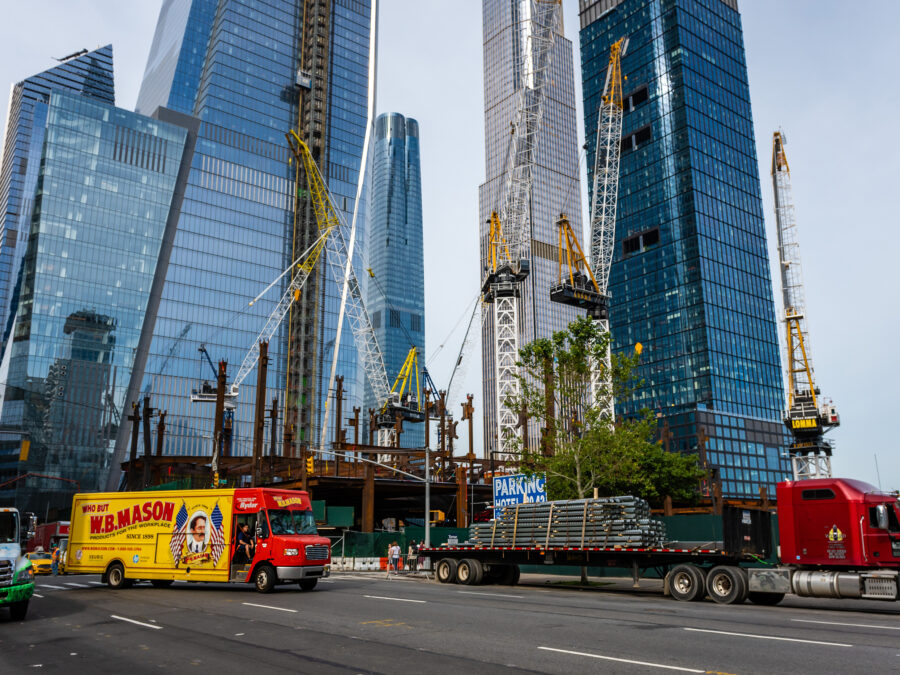2023 Outlook: NYC Construction Is Back and Booming
By Frank Fortino
Here we are in the New Year, and the New York City building industry is bounding back with a vengeance. With luck, the COVID-19 pandemic will find its way into the rearview mirror for good. Perhaps to make up for lost time, construction spending and building levels are projected to make huge gains over the next three years, according to the 2022 – 2024 New York City Construction Outlook, published by the New York Building Congress.
Once again, this signature publication includes additional figures adjusted for inflation as the increased cost of labor and materials, as well as delays in federal infrastructure investments, continues to plague our industry.
An Exciting Outlook with Caveats
Driven by unprecedented upheaval in workforce patterns and economic trends, coupled with the historic Infrastructure Investment and Jobs Act of 2021 (IIJA), construction spending is forecasted to hit $86 billion in 2022, up $38 billion in inflation-adjusted dollars over the previous year. Spending is projected to increase by another $10 billion by 2024, with the three-year total expected to hit $270 billion in nominal dollars ($250 billion, adjusted for inflation).
Compared to pre-COVID numbers—the three-year period from 2017 to 2019—these projections reflect an inflation-adjusted increase of $37.8 billion.
Meanwhile, employment numbers are also projected to trend upward, but at a significantly lower rate. Employment in building construction, heavy and civil engineering, and specialty trades is expected to total 139,000 in 2022, up almost 3% from 2021. This level is expected to creep upward at about the same pace next year, to 143,000 in 2023, then hold steady in 2024, at around 142,500.
The spending jump in 2022-2024 represents a combination of two things: increases in materials cost and recovery from depressed construction activity in 2020-2021. This is evidenced by the drop in the number of jobs per $1 million spent, from 3.1 in 2021 to 1.6 in 2022 and 2023.
After the pandemic slump, these heartening jumps are a testament to New Yorkers’ determination and resilience. However, we should temper our exuberance with a couple of caveats. Cutbacks in development or a reduction in price increases could have an adverse effect on these projects. Also, the tax incentives associated with 421-a, which expired in spring 2022, do not yet have a suitable replacement.
Residential Boom Drives Additional Floorspace
The Big Apple is growing residential floorspace at bumper crop levels. In 2019, 103.3 million gross square feet (GSF) were added to New York City properties. In 2022, we expect another 105.1 million GSF, 68% of which is residential development. This increase is expected to accelerate to 110.8 million GSF in 2023 and 118.2 million GSF in 2024.
The increase in residential spending in the next three years over pre-pandemic 2017-2019 will be almost 70% in nominal dollars, nearly $93 billion.
A notable statistic over the past three years has been the rehabilitation and renovation of existing interiors, which accounted for 23% of the increased construction spending from 2019-2020. In 2022, the average cost of $400+ per square foot of new housing points to vigorous investment in renovations.
From now until 2024, a projected 30,000 new units per year will be developed, rather than renovated, which will reduce the per-square-foot cost of residential spending. The aggregate residential investment in 2022 was estimated at $31.8 billion and is forecast to reach $32.5 billion in 2024.
Non-Residential Construction Tops Residential Boom
Not to be outdone, non-residential spending—office space, retail, lodging, entertainment venues, recreational facilities, etc.—is expected to reach $106 billion (in non-adjusted dollars) between 2022 and 2024, a 57% rise from 2017-2019. When all the numbers are crunched, non-residential spending is expected to have claimed an even larger share in 2022, 39% of all construction spending, up 5% from the previous year.
Much of that increased share came from the new construction of healthcare facilities and large offices. Manhattan’s population of office buildings expanded in 2019, with more than a dozen new buildings adding office floorspace of 10 million GSF. The past two years, 2020-2021, contributed 11 new and converted buildings that exceeded 4 million GSF of office floorspace Three megatowers are close to completion now, totaling another 6 million GSF, and after that, from 2023-2024, five more skyscrapers promise 10 million more square feet of office space. Several more major office buildings are on the horizon as well.
The COVID-19 pandemic drove significant demand for investment in healthcare and educational facilities, as well as some investment in warehouse and storage development. By contrast, spending on commercial developments like retail and hotels has declined.
All of this adds up to projections of more than $33.7 billion in nonresidential construction spending for 2022.
Public-Sector Spending Holds Promise
During the COVID period, government spending on construction exceeded one-third of the city’s total construction investment, the result of an even steeper decline in private construction. Public-sector spending is expected to increase annually from $20.8 billion in 2022—more than 30% above average public-sector spending from the previous two years—to $23.6 billion in 2023 and $26.9 billion in 2024.
Thanks to the IIJA, the lion’s share of government spending on construction is expected to improve infrastructure, although the benefits of this act have yet to be determined. The City of New York, the Metropolitan Transportation Authority, and the Port Authority have $50.5 billion budgeted for 2023-2024, but this number may shift if agency priorities are realigned.
The construction industry looks vastly different than it did two years ago, with investment flowing once more and construction workers back on the job in healthy numbers. The next couple of years promise to see a continued rebound, and we’re excited to work together to build a better New York.


